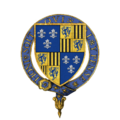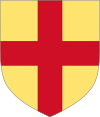Baron Burgh facts for kids
Quick facts for kids Baron Burgh |
|
|---|---|

Arms of Thomas Burgh, 1st Baron Burgh
|
|
| Creation date | 1327 (1st creation) 1487?/1529 (2nd creation) |
| Monarch | Edward III Henry VII |
| Peerage | Peerage of England |
| First holder | William de Burgh, 3rd Earl of Ulster (1st creation) |
| Last holder | Edward IV (1st creation) |
| Present holder | Alexander Leith, 8th Baron Burgh |
| Heir apparent | Alexander Leith |
| Status | Extant (2nd creation) |
| Extinction date | 1461 (1st creation) |
Baron Burgh (pronounced like "Burr" or "Burra") is a special old title in England. It has been created twice in the Peerage of England. A "peerage" is a system of titles like Duke, Earl, or Baron. These titles are usually passed down through families.
The first time the title was created was in 1327 for William de Burgh. This title later joined with the Crown (meaning the King or Queen) in 1461.
The second time the title was created is a bit unclear. No one with the Burgh name was officially in the House of Lords (a part of the British Parliament) before 1529. However, the grandfather of one Lord Burgh was asked to join in 1487, but he never actually sat there. This made it tricky to decide if a new title was truly created then.
This Barony was "on hold" for more than 300 years. This is called being in abeyance. When it was finally brought back in 1916, it was given the earlier date of 1487.
Contents
History of the Burgh Title
First Creation: 1327
William de Burgh, 3rd Earl of Ulster was asked to come to the English Parliament in 1327 and 1328. This invitation, called a "writ," meant he was given the title of Baron Burgh.
He was also called to Parliament in 1331 as the Earl of Ulster to talk about things happening in Ireland.
These English titles later became part of the Crown. This happened when his descendant, Edward IV, became King in 1461.
Second Creation: 1487 and 1529
Sir Thomas Burgh of Gainsborough was a very important supporter of the Yorkist side during the Wars of the Roses. He was asked to come to Parliament in 1487 by Henry VII of England. But there is no proof that he actually went.
The King wanted to make him a Baron, but no official document or second invitation was sent. Even though he received invitations, he never attended Parliament as a peer. Official papers still called him a knight, not a Baron.
His son, Sir Edward Burgh, was never asked to join the House of Lords. He was elected to the House of Commons while his father was still alive. In 1510, he became unwell and was described as "distracted of memory."
Sir Edward's son, also named Thomas Burgh, was invited to Parliament after his father passed away. He was officially accepted on December 2, 1529. At that time, people saw this as a brand new creation of the title.
Today, the events of 1487 would not usually count as creating a title. This is because the elder Sir Thomas never actually sat in Parliament as a peer. However, when the title was brought back in 1916, it was given the earlier date of 1487.
Because of this, some people call the younger Sir Thomas the 1st Baron Burgh, while others call him the 3rd. In this article, we will call him the 1st Baron, but remember he is considered the 3rd by modern rules.
What is "Abeyance"?
The most famous of the Lords Burgh was Thomas Burgh, 3rd Baron Burgh. He was an important official in Ireland. When he died in 1597, he had four daughters and a very young son.
When his son passed away at the age of eight, the title of Baron Burgh went into "abeyance." This means the title was put "on hold" because there was no clear single heir.
Each of his daughters had a share of the title. None of them could hold the title unless the King or Queen decided which one of their families should have it. In this case, it wasn't decided until 1916.
One of the daughters, Elizabeth, married George Brooke. His family faced difficulties with King James I. Even so, Elizabeth Brooke's rights to the title were not affected. The title was eventually given to one of her descendants.
Bringing the Title Back
By the late 1700s, Elizabeth Brooke's share of the title was passed to Sir William Boothby. When he died in 1787, his sister, Mrs. Mary Disney, inherited the right to the Burgh title.
She had six daughters, and three of them had children. This long line of inheritance eventually led to the title being officially brought back in 1916.
Barons Burgh, First Creation (1327)
- William de Burgh, 3rd Earl of Ulster, 1st Baron Burgh.
De Jure Barons Burgh, Second Creation (1487–1529)

- Thomas Burgh, considered the 1st Baron Burgh (1431- 1496)
- Edward Burgh, considered the 2nd Baron Burgh (1464-1528)
Barons Burgh, Second Creation (1529)
- Thomas Burgh, 1st Baron Burgh (1488-1550), also known as the 3rd Baron by the 1916 decision.
- William Burgh, 2nd Baron Burgh (1522–1584), also known as the 4th Baron.
- Thomas Burgh, 3rd Baron Burgh (1558–1597), also known as the 5th Baron. He was an ambassador and a leader in Ireland.
- Robert Burgh, 4th Baron Burgh (1594–1602), also known as the 6th Baron.
- The title went into abeyance (on hold) in 1602.
Barons Burgh, Second Creation (1529; Revived 1916)
- Alexander Henry Leith, 5th Baron Burgh (1866–1926) (the title was brought out of abeyance in 1916)
- Alexander Leigh Henry Leith, 6th Baron Burgh (1906–1959)
- Alexander Peter Willoughby Leith, 7th Baron Burgh (1935–2001)
- Alexander Gregory Disney Leith, 8th Baron Burgh (born 1958)
The person who will inherit the title next is the current Baron's son, Alexander James Strachan Leith (born 1986).
See also
- House of Burgh
- Baron Strabolgi
- Baron Cobham (1313 creation)
Re-enactment
- Sir Thomas Lord Burgh K.G.'s Retinue (1460–1496) Historical Interpretation and Living History from the Wars of the Roses
- City of Lincoln Waites The Mayor of Lincoln's Own Band of Musick



